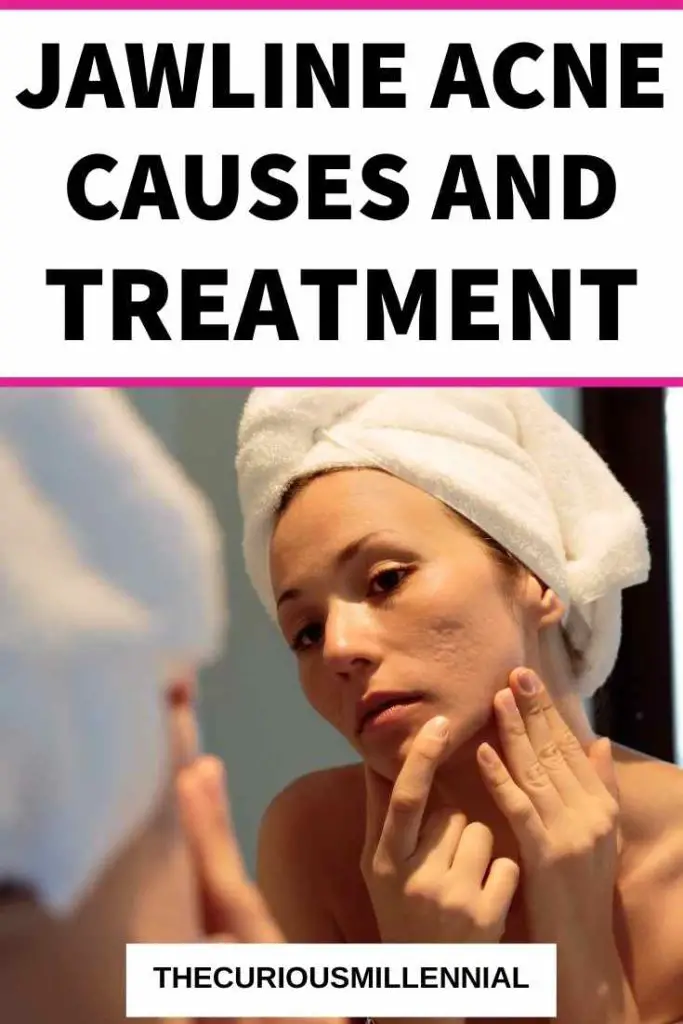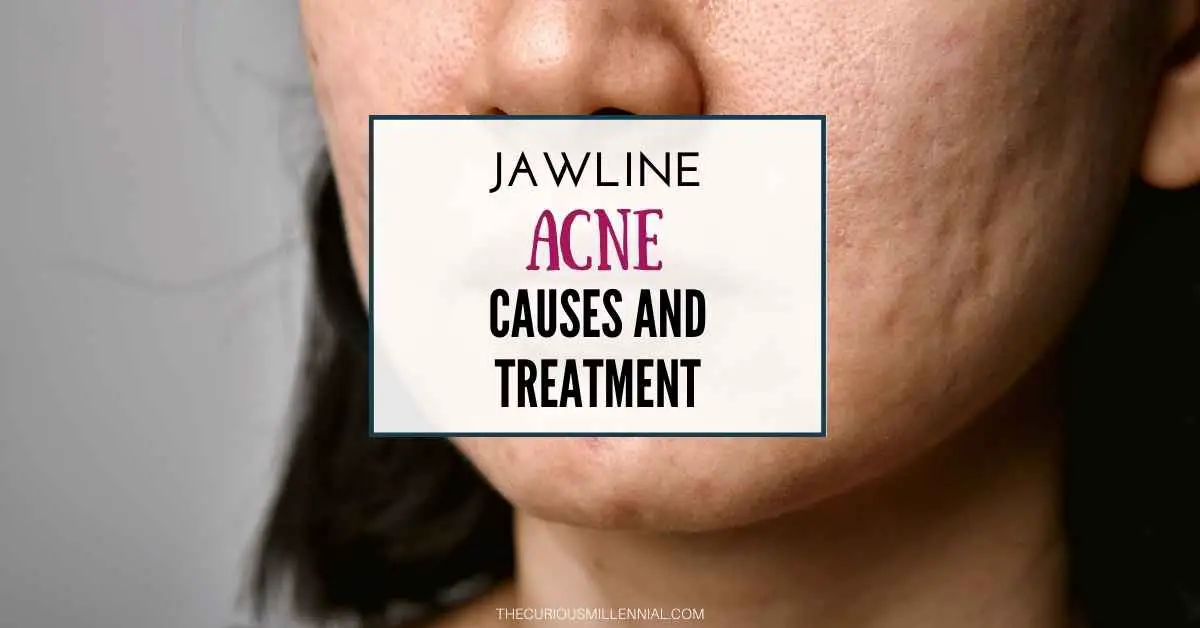Acne is a common skin condition that affects people of all ages. Acne can cause pimples, blackheads, and other blemishes on the skin. While acne is most commonly associated with teenagers, it can also affect adults. In fact, adult acne is becoming increasingly common.
Jawline acne is a particular type of acne that affects the jawline and neck. It can be difficult to treat, and there are several factors that can contribute to its development.
In this article, we will discuss what causes jawline acne and how you can treat it.
What Do Spots On The Jawline Mean?
Most people associate spots with acne, but there are actually several different types of spots that can affect the skin.
Acne is a general term used to describe pimples, blackheads, whiteheads, and other blemishes on the skin. These blemishes are usually caused by excess oil and dead skin cells clogging pores.
Jawline acne specifically refers to blemishes that appear on the jawline and neck. These blemishes can be just as painful and unsightly as other types of acne.
What Causes Jawline Acne?
There are several factors that can contribute to the development of jawline acne. The most common causes include:
Hormonal Changes
Hormonal changes, such as those that occur during puberty, pregnancy, and menopause, can contribute to the development of jawline acne.
During the premenstrual stage, when a woman’s hormones are shifting and progesterone levels in her skin rise, her face might appear puffy. This puts pressure on the pores and narrows the pore lining. Furthermore, because of an imbalance of hormones and an increase in testosterone during the premenstrual hormonal shift, oil may become thicker and more likely to clog pores.
Pregnancy can also cause changes in hormone levels, which may lead to jawline acne. Androgens, a type of male hormone, increase during pregnancy. These hormones can stimulate the sebaceous glands, which secrete oil, leading to clogged pores and breakouts.
Bacteria
Acne is caused by bacteria that accumulates in the pores of the skin. The bacteria known as Propionibacterium acnes is responsible for the majority of acne cases.
This bacteria feeds on the sebum that is produced by the sebaceous glands. When there is an overproduction of sebum, as is often the case with hormonal changes, the bacteria can multiply and cause acne breakouts.
Diet
What you eat can also play a role in the development of jawline acne. Foods that are high in sugar and saturated fats can contribute to the development of acne.
Acne is not caused by chocolate or greasy foods, but these foods can aggravate acne symptoms. Dairy products may also aggravate acne, as they contain hormones and other substances that can contribute to breakouts.
Stress
When the stress hormones are released, they cause the release of molecules that promote blood flow to the skin. The same chemicals might induce rashes and redness as well, depending on your individual makeup.
Moreover, tension affects our immune responses, which might result in certain skin problems.’ (Think rosacea and eczema.)
Oil Production
Sebaceous glands produce an oil called sebum, which helps to lubricate and protect the skin. However, too much sebum can lead to clogged pores and acne.
Environmental Factors
External factors, such as pollution and sunlight, can also aggravate acne symptoms. Sunlight can increase the production of oil by the sebaceous glands and can also damage the skin.
How To Treat Jawline Acne

There are several ways that you can treat jawline acne. The most effective treatments include:
Topical Treatments
Topical treatments, such as retinoids, benzoyl peroxide, and salicylic acid, can help to unclog pores and reduce inflammation. These treatments are available over the counter or by prescription.
Retinol is a skincare superstar for a reason: it promotes cell turnover, unclogs pores, and removes even hidden breakouts. It also aids other topical treatments in working more effectively thanks to all of the pore-clogging power. Retinol is an excellent choice for adult women since it has anti-acne as well as anti-aging advantages.
Benzoyl peroxide is a common ingredient in acne treatments. It helps to kill the bacteria that causes acne and reduces inflammation.
Salicylic acid is another common ingredient in acne treatments. It helps to remove dead skin cells and unclogs pores.
Oral Medications
Topical treatments might be quite beneficial; however, they can only achieve so much in terms of breakouts. Antibiotics are absorbed into the body, circulated throughout it, and targeted at the sebaceous glands’ root cause: bacteria.
This is why oral antibiotics are sometimes prescribed for the treatment of acne, in addition to topical treatments.
Commonly prescribed anti-acne antibiotics include tetracyclines, erythromycin, and clindamycin. These antibiotics help to kill the bacteria that cause acne and reduce inflammation.
Hormonal Treatments
For women who have acne breakouts due to hormonal changes, such as during the menstrual cycle or pregnancy, birth control pills might be recommended. Birth control pills can help to regulate hormone levels and reduce the severity of acne breakouts.
Isotretinoin (Accutane)
Isotretinoin is a powerful medication that is used for the treatment of severe acne. It is a form of vitamin A that helps to reduce the production of oil by the sebaceous glands.
Isotretinoin is only available by prescription and can cause a number of side effects, such as dry skin, hair loss, and birth defects. It is important to discuss the risks and benefits of isotretinoin with your doctor before starting treatment.
Acupuncture
Acupuncture is an alternative medicine treatment that involves the insertion of needles into the body. There is some evidence that acupuncture may be beneficial for the treatment of acne.
Procedural Treatments
Procedural treatments, such as laser therapy and chemical peels, can be used to reduce the appearance of acne scars.
Common peels for acne-prone skin are glycolic acid, salicylic acid, and lactic acid peels.
Laser therapy uses pulsed light to target the sebaceous glands and reduce oil production.
Home Remedies
There are several home remedies that you can use to treat jawline acne. These include:
Tea Tree Oil
Tea tree oil has antibacterial and anti-inflammatory properties that can help to treat acne.
Aloe Vera
Aloe vera has soothing and healing properties that can help to reduce the inflammation caused by acne.
Honey
Honey has antimicrobial properties that can help to kill bacteria and reduce inflammation.
Coconut Oil
Coconut oil has moisturizing and anti-inflammatory properties that can help to treat acne.
Jawline acne can be a difficult condition to treat. However, there are several effective treatments available. If you are struggling with jawline acne, talk to your doctor or dermatologist about the best treatment options for you.
Prevention
Prevention is key when it comes to jawline acne. There are several things that you can do to reduce your risk of developing this condition. These include:
- Washing your face twice a day with a gentle cleanser
- Avoiding excessive sun exposure
- Using a sunscreen when outdoors
- Avoiding contact with irritants, such as harsh chemicals and cosmetics
- Staying hydrated
- Eating a healthy diet rich in fruits and vegetables
- Exercising regularly
- Managing stress levels
- Keep your hands away from your face
- Avoid helmets that have tight straps
- Use non-comedogenic cosmetics and skincare products
- Don’t pop or pick at pimples
If you follow these tips, you can help to reduce your risk of developing jawline acne.
What Other Conditions Cause Jawline Acne?
In some cases, jawline acne can be a sign of another medical condition. Some of the most common conditions that can cause jawline acne include:
Rosacea
Rosacea is a skin condition that causes redness and inflammation of the face. It can also cause acne-like lesions on the face.
Lupus
Lupus is a chronic autoimmune disease that can cause inflammation and lesions on the skin.
Crohn’s disease
Crohn’s disease is a chronic inflammatory bowel disease that can cause inflammation and lesions on the skin.
If you are experiencing jawline acne, it is important to see your doctor to rule out any other medical conditions.
Outlook
Within a few days, pimples on the jawline will typically disappear by themselves. Acne that is persistent might take several weeks to clear. It should get better with doctor’s treatments.
Even if your acne has gone away, you may need to continue using the treatment. You’ll avoid future outbreaks and scars by continuing to take your medicine.
If you have deep scars, you might talk to your doctor about laser treatments or chemical peels. These can help to improve the appearance of your skin.
Related Read: Types Of Acne Explained

